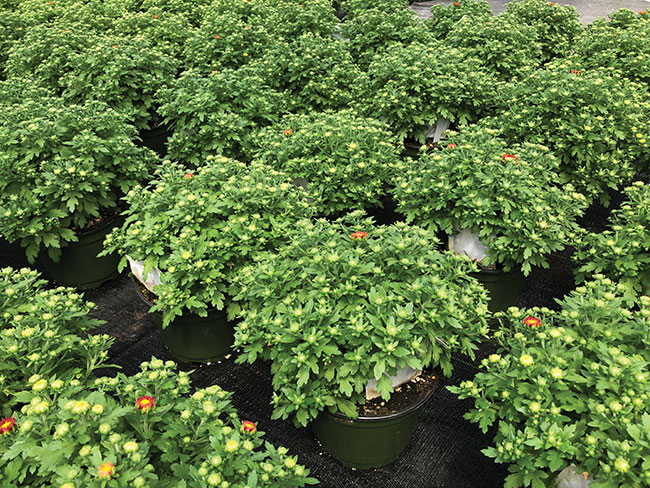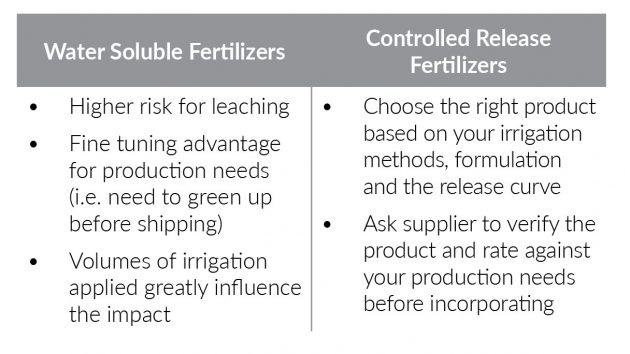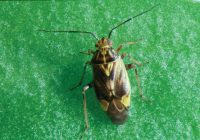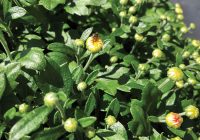
Features
Crop Culture
Crop Protection
Fertilizer
Flowers
Garden mums: To produce and protect
From irrigation and fertilizer to pests and diseases, optimize your garden mum production with these quick pointers.
August 25, 2020 By Dr. Sarah Jandricic and Dr. Chevonne Dayboll
 One mite-sachet per pot provides protection against thrips when garden mums are grown inside. Tuck sachets within the plant canopy to provide the right humidity for optimal performance. All photos credited to: OMAFRA
One mite-sachet per pot provides protection against thrips when garden mums are grown inside. Tuck sachets within the plant canopy to provide the right humidity for optimal performance. All photos credited to: OMAFRA Summer is in full swing and so too are garden mums. Although generally an easy crop, there are several tweaks you can make to help save headaches and money. Here are some pointers to help optimize your irrigation, fertilizer and pest management programs in garden mums.
Irrigation method matters
Given the large acreage often occupied by garden mums, your watering strategy is one place where you can look to save money.
There are plenty of options for irrigation in potted outdoor crops, but not all are created equal when it comes to maximizing water efficiency. Overhead irrigation by boom, or sprinkler is not efficient if your pots are not spaced tightly. Canopy sizes in the later months of production may make this impossible, especially if you choose to go with final spacing when the pots first move outside. These methods of irrigation can also lead to pots that are too dry (not watered) or too wet (over watered). Plants can only use water that makes it into the pot, so low volume drip line or tape is more effective for delivering usable water to your outdoor crops.
Remember, drip line only reduces lost irrigation volumes if it is used properly. A “set it and forget it” approach doesn’t work. Look for kinked lines and clogged emitters, and make sure connections are tight. Know your application volumes and irrigate based on crop needs and weather patterns, not a set schedule.
Fertilizer choice
There are a few schools of thought when it comes to fertilizer types for garden mums. Some growers prefer to have more control over crop nutrition and choose water soluble mixes. The benefit of this is that mixes can be quickly changed if needed. Others choose to use controlled release fertilizers incorporated into the growing media and then irrigate with water only. Both have their pros and cons.
As with irrigation, nutrients that don’t stay with the plant can’t be used by it. The amount of nutrients staying with the plant are usually highest when controlled release fertilizers (CRFs) are used with carefully monitored irrigation. Nutrients are usually lowest when water soluble fertilizers are applied in high volumes (resulting in a lot of irrigation running through pots) and irrigation efficiency is low. To keep the fertilizer where you want it, it’s important to irrigate only enough to saturate the pot. Both formulations have their pros and cons, so make sure whatever you’ve chosen is easily managed.

Pest Issues
The good news is that garden mums grown outdoors simply don’t have the same pest pressures as pot mums. Why? A lot of this has to do with natural enemy populations from surrounding agricultural lands that seem to keep a lot of pests in check. To conserve these free biocontrol agents, avoid spraying if you can. If you do spray, choose a product that is compatible with beneficials so you don’t end up with a larger problem on your hands from secondary pests. The following are some pest issues you may see.
Thrips: Rarely a problem outside, western flower thrips – and even onion thrips – can affect garden mums grown indoors. Unfortunately, this species of chrysanthemum generally does not tolerate the usual recommendation of oil dips for cuttings. A better bet is to reduce incoming thrips on this crop (which you should consider as “sensitive”) using dips in BotaniGard. After sticking, predatory mite sachets (one per pot) are your best bet for long-term protection of spaced plants. Rather than Amblyseius swirskii, A. cucumeris is the more economical choice for this crop. Given how quickly the crop grows, penetration of the soil with drenches of nematodes may not be feasible within a few weeks. A good secondary measure would be foliar applications of Beauveria-containing biopesticides (e.g. BotaniGard, BioCeres), if needed. Growers also use a high density of large mass trapping cards in this crop to help avoid thrips infestations from fly-ins in the summer. A density of 8 cards per 1,000 square ft. is suggested for floriculture crops (approximately four cards per bench).
Aphids: We sometimes see these pop up in garden mums. If they do become a problem, and it seems to happen later in the season (late August/September), wait to apply pesticides until you actually see them. This also helps to avoid unnecessary applications. Beleaf (flonicamid) is a good option as it is a) soft on beneficials, b) can be applied via drench through irrigation lines, and c) cheap! Altus is a newer registration that is also a good option for aphids and other sucking pests.
Tarnished plant bug: Also known as the Lygus bug, TPB can be an issue in August once buds form. It is particularly damaging, as their bud feeding causes severe flower deformation. Frequently, one variety or one side of the field gets hit first. Make sure to walk the crop regularly, and look for adult bugs and aborted petals on open flowers. TPB can be controlled with pesticides applied for other sucking insects (e.g. aphids).
Leafhoppers: These can fly in from the same surrounding agricultural lands as your free natural enemies and can seem like an issue since they jump around plants as you pass by. The good news is, they don’t seem to do any real damage to crops. Resist the urge to spray, and simply make sure that your workers give the plants a good shake to dislodge any adults before packing.
Japanese beetle: While generally not a problem on garden mums, recall that all plants produced outside from June 15 to September 30 need to be treated for JB if you plan to export or ship to a JB-free zone.
Diseases: Chrysanthemum white rust – a quarantinable disease – is theoretically possible, but it has only been detected once in Ontario in the last decade thanks to regulations requiring plant material to be sourced from white rust-free facilities. Still, many growers treat with Nova (myclobutanil) as a precaution, especially when exporting. Other diseases such as bacterial blight, Fusarium, Pythium and Rhizoctonia are more common, but generally aren’t big issues in Ontario production. If problems develop, a good guide to disease symptoms and cultural management in garden mums can be found on this fact sheet from the University of Kentucky (https://plantpathology.ca.uky.edu/files/ppfs-or-h-10.pdf).
Want to improve your natural enemy predation outside? Some growers in the U.S. use banker or “companion” plants such as alyssum, calendula and borage along field edges to attract parasitic wasps, Orius and syrphid flies.
This article was adapted from the authors’ ONFloriculture blog. For more on mum and hydrangea production, water and fertilizer use, sensitive crops, particular pests and diseases mentioned and more, visit ONFloriculture.com.
Chevonne Dayboll, PhD, is the greenhouse floriculture specialist and Sarah Jandricic, PhD, is the greenhouse floriculture IPM specialist for the Ontario Ministry of Agriculture, Food and Rural Affairs. They can be reached at chevonne.dayboll@ontario.ca and sarah.jandricic@ontario.ca
Print this page


